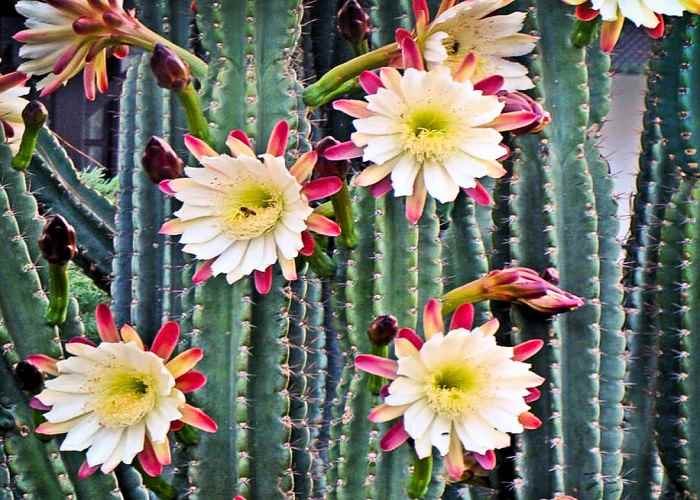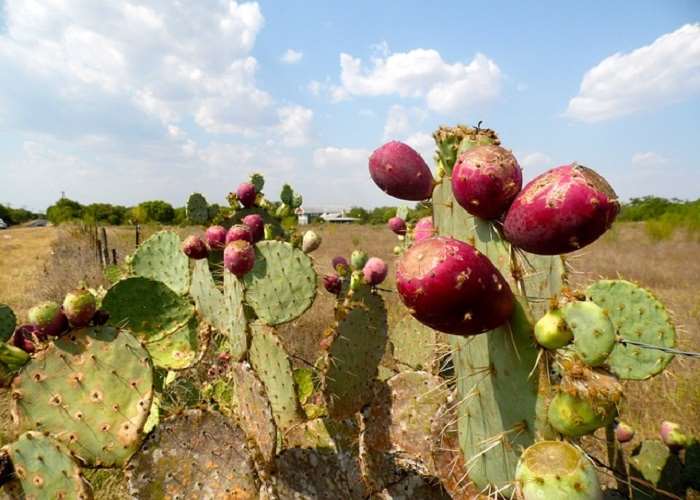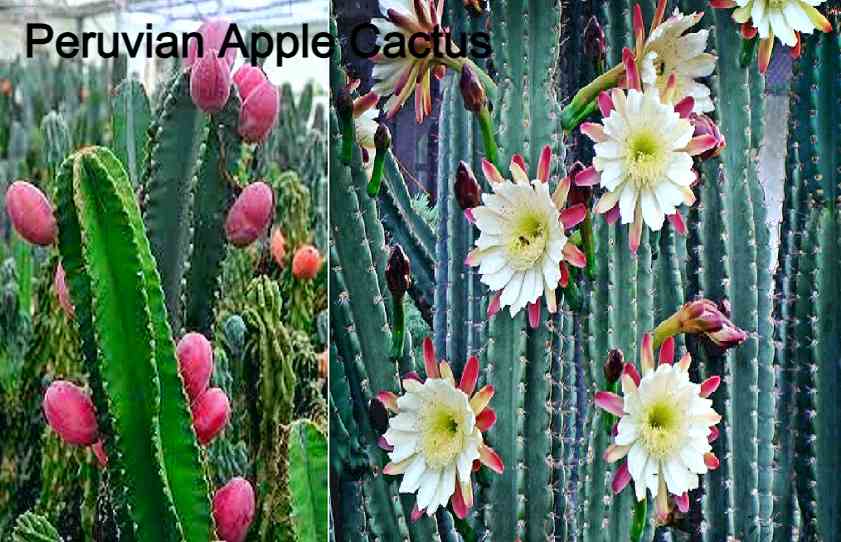The Cereus Repandus, or Peruvian apple cactus, is a massive columnar cactus that originated in the Andean regions of South America, specifically in Peru. In its native environment, the columnar, tall Peruvian apple cactus can reach a height of forty feet (12 meters). It resembles a tree because of its numerous vertical stems, which can branch out.
Clusters of spines adorn the ribbed stems. The common name comes from the fact that mature Peruvian apple cactus fruit plants can produce edible red or yellow fruits that resemble apples, as well as lovely, fragrant white Peruvian apple cactus flower that blooms at night. In this article, we will discuss the harvesting of Peruvian apple cactus.
Techniques For Propagating Peruvian Apple Cactus:
A variety of techniques exist for propagating the Peruvian apple cactus, the most common of which are stem cuttings and seeds.
Stem Cuttings:
- To propagate a Peruvian apple cactus fruit, choose a stem that is both mature and in good health. The ideal length of the stem is several feet, and it should have multiple ribs.
- Slice off a piece of stem using a sharp, clean knife or pruning shears. A length of 8 to 12 inches is ideal for the cutting.
- You can lessen the likelihood of rot by cutting a few days to dry and callus. Keep it somewhere dry and shady.
- Get a potting mix that drains well, like a cactus mix or a combination of perlite and sandy soil.
- Plant the cutting an inch deep in the potting mix after it has been called. When planting, keep it upright and push the soil up around the base.
- To water the cutting gently, wet the soil just enough to dampen it; after the soil has dried out, water it again.
- Set the potted cutting somewhere that gets plenty of indirect light.
Plant seeds:
- Pick ripe apples off a fully-grown Peruvian apple cactus. To get to the seeds, cut the fruits in half.
- Remove any pulp or flesh from the seeds by rinsing them, and then let them air dry for at least a day or two.
- Get a mixture of perlite, sandy soil, or cactus mix that drains well and use it to start seeds.
- Gently press the seeds into the seed-starting mix as you sow them on top. Be careful not to bury them too deeply.
- To moisten the soil without making it soggy, lightly spray it.
- To keep moisture in the container, cover it with a plastic dome or wrap it in plastic to make it look like a greenhouse.
- To keep the contents warm, put the container in a spot that gets indirect light.
- Keep the soil consistently damp, but not soggy. Keep an eye on the soil and water it as needed to maintain its moisture level.
- The time it takes for seeds to germinate can range from a few weeks to a few months, depending on the weather.
Criteria for Successfully Cultivating the Peruvian Apple Cactus

A few things you should keep in mind are as follows:
Light
Because of its adaptations, the Peruvian apple cactus can only survive in full, intense sunshine. At its healthiest and most prolific, it needs six or eight hours of sunshine every day. The best thing you can do for its health is to put it somewhere bright and sunny.
Soil
For the foundation, use a pre-made cactus mix. For succulents and cacti, these mixes are tailor-made to ensure adequate drainage and air circulation.
The Peruvian apple cactus fruit plant mixes are available at garden centers already mixed or can be homemade using equal parts pumice or perlite to ordinary potting soil.
Water
Although they do best with infrequent watering, Peruvian apple cactus can withstand periods of drought. In between waterings, make sure the soil dries out. Climate, season, and potting mix are a few of the variables that will determine how often to water.
In general, when your Peruvian apple cactus is actively growing (spring and summer), water it every two to three weeks. When it is dormant (fall and winter), water it less frequently.
Poke a finger into the dirt an inch or two deep to see how moist it is before watering. At that depth, if the soil feels dry, it’s time to water. You should wait a few more days before watering it if it feels slightly moist.
The temperature
Temperatures between 21 and 32 degrees Celsius (70- and 90 degrees Fahrenheit) are ideal for Peruvian apple cactus. The range offers the perfect environment for the plant to grow, mature, and bloom.
The Care of Peruvian Apple Cacti
Here we will discuss the details of Peruvian apple cactus care:
Fertilizer
If you want your fertilizer to be balanced you must look for a 10-10-10 or 20-20-20 NPK ratio. In addition to promoting vegetative growth and fruit development of the Peruvian apple cactus flower plant, this balanced ratio also supports the overall health of the plant.
During the spring and summer, when Peruvian apple cactus flower and fruit are actively growing, is the best time to fertilize them. To the directions on the product’s packaging, apply the fertilizer every four to six weeks.
Pests and Diseases

Pests like mealybugs, snails, and slugs are common problems for Peruvian apple cactus fruit plants. You have two options for dealing with mealybugs: organic insecticides or rubbing alcohol-soaked cotton swabs for delicate removal.
Conclusion
The fun fact is that Peruvian apple cactus hallucinations properties which have been famous since early ages. Although the common perception is that all cacti are arid, spineless plants native to deserts, this is not necessarily the case. No two cacti are alike; in fact, some cacti even have fruit. Some species of cactus grow in South and Central America; one of these, the Peruvian apple cactus, is known for its sugarcane-like fruit.
FAQs
Q: In what conditions does the Peruvian apple cactus thrive?
A: Prefers bright, indirect sunlight and thrives in sunny locations, such as greenhouses and rooms with plenty of windows (when grown indoors). In addition to full sun, they can also thrive in partially shaded regions.
Q: How does the Peruvian apple cactus help one’s health?
A: The fruit of the Peruvian apple cactus tree is rich in minerals that the body needs, including calcium, magnesium, and potassium. Several bodily processes rely on these minerals, such as the conduction of nerve impulses, the contraction of muscles, and the maintenance of healthy bones.
Q: Can one get poison from a Peruvian apple cactus?
A: Unless you get a severe frost or freeze, the South American species Cereus Repandus, commonly known as the Peruvian apple cactus, thrives here. You can eat the fruit.
Recommended Post:
- Pink Princess Philodendron: Tips to Grow and Take Care
- Ranunculus Flower: Everything You Need To Know
- Know about Types, Characteristics, Blooming Time, and Plantation of Pink Snapdragon Flower

